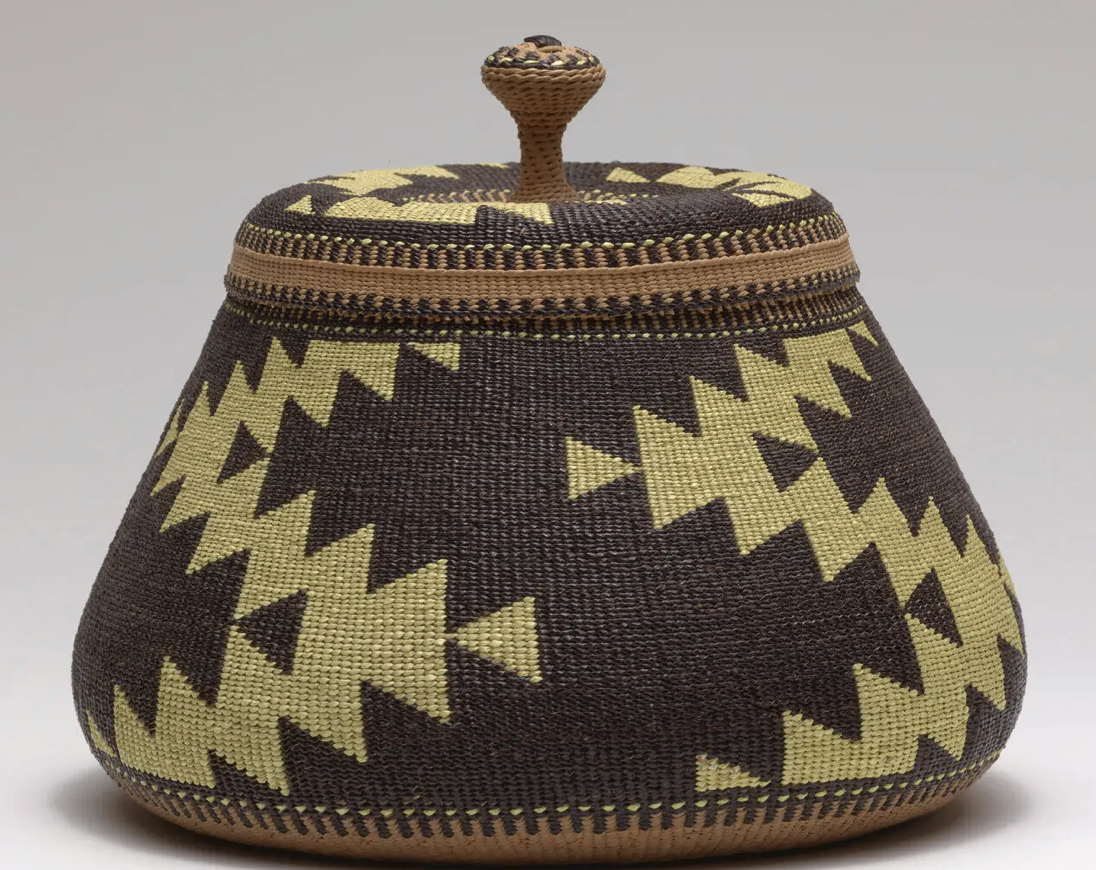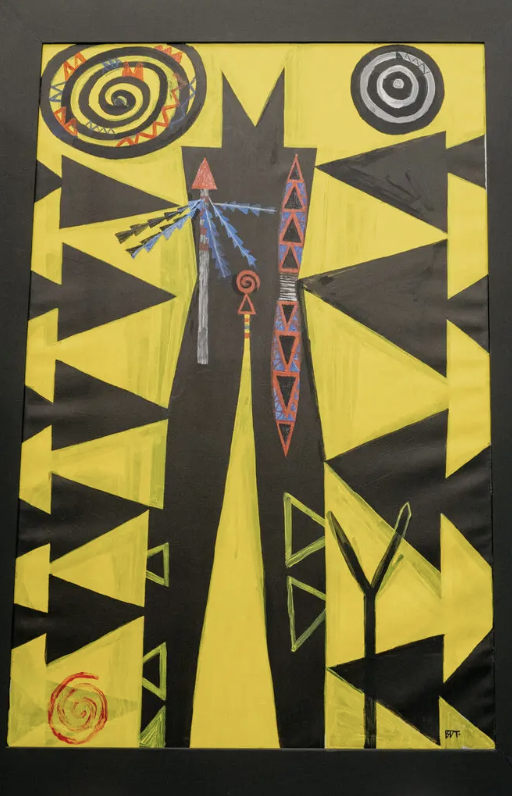Not (Just) Your Grandparents’ Indigenous Art
Arts of Indigenous America
de Young
Ongoing – August 31, 2028
LAND ACKNOWLEGEMENT
The Fine Arts Museums of San Francisco are located on land unceded by the Ramaytush Ohlone, who are the original inhabitants of what is now the San Francisco Peninsula. The greater Bay Area is also the ancestral territory of other Ohlone peoples, as well as the Miwok, Yokuts and Patwin. FAMSF acknowledges, recognizes and honors the Indigenous ancestors, elders and descendants whose nations and communities have lived in the Bay Area over many generations and continue to do so today. FAMSF respect the enduring relationships that exist between Indigenous Peoples and their homelands and is committed to partnering with Indigenous communities to raise awareness of their legacy and engage with the history of the region, the impacts of genocide and the dynamics of settler colonialism that persist today.
Bartow, Magical Mind of Rural America. At 18 feet across by more than 6 feet high, Bartow’s work is monumental.
PREFACE
When approaching a subject like the revitalizing of a museum’s entire Indigenous Art collection, there is the danger of saying too much or too little. If you are familiar with these Blogs, you know I’m likely to err on the side of the former. So it is again. Yet, in my defense, I cannot think of a better subject for you, Dear Reader, to spend a few extra minutes perusing and considering than the quality of Indigenous Art at the de Young.
Hickox, Basket
In May, a group of curators from the Indigenous Art galleries paused to admire a grapefruit-sized basket by Elizabeth Hickox, an early 20th-century basket weaver from Northern California (Wiyot & Karuk), who remains renowned for her unusual forms and bold patterns — zigzags and lightning bolts rendered in luminous yellows against deep browns and inky blacks.
“These are like Picassos,” said Pimm Tripp-Allen (Karuk/Yurok) , an Indigenous scholar and curator, “though I don’t even want to compare her to Picasso.” “They are better than Picassos!” interjected Sherrie Smith-Ferri, another curator (Pomo & Miwok), as she inspected the delicate woven knob on the basket’s lid and the perfect circular pattern within — not a warp or weft out of place.
[Those of you who are frequent readers of these Blogs already know of my indignation over the spurious art/craft divide. Whatever the tool, whatever the medium, it is the soul of the maker that creates art or craft. When you lack access to oil paints and canvas and you are an artist, you make art with the supplies on-hand: pine roots, porcupine quills, shells, clay, etc. Had Picasso been born Lisjan (Ohlone Nation), he’d have used grasses, bark and feathers also.]
THE WAY WE WERE
When it first opened its doors in 1985, the de Young already had a well-respected Indigenous Art collection, particularly Native American art from the Western United States: Pueblo pottery, Diné (Navajo) textiles and California baskets, stemming from the items acquired after the 1894 California Midwinter International Exposition. The collection grew significantly over time, with gifts from collectors and estates, including:
Ancestral ceramics by Pueblo potters and carvings and regalia from the Pacific Northwest;
Contemporary Pueblo pottery, and
Nearly 400 works by Alaska Native and Canadian Inuit artists, past and present.
REENVISIONING THE INDIGENOUS ART GALLERIES
In 2023, the Biden Administration updated the Native American Graves Protection and Repatriation Act (NAGPRA) by requiring museums to get consent before exhibiting cultural items and to incorporate traditional Indigenous knowledge into their handling of these items.
The de Young used these regulations as a springboard to completely revamp their collection. As a result, after a nine-month reevaluation, the de Young has opened a new, long-term installation collaboratively developed by a group of predominantly Native American co-curators, foregrounding Indigenous Values and Voices.
Now, contemporary artworks, new acquisitions and commissions will be on view alongside ancestral works, demonstrating interconnection between artists past and present. This new presentation of Native American art celebrates the vibrancy and diversity of Indigenous Arts of the Americas. Visitors will enjoy works spanning over a thousand years of history and incorporating many diverse types of media, challenging expectations about what Native Art is and can be. At the same time, any queasy sensations visitors might otherwise experience over the acquisition of the pieces will be allayed, resulting from the rigorous review by the team of Indigenous co-curators.
Mix of Ancestral and Contemporary
RELATIONSHIP TO PLACE
Rather than grouping art by type: basketry, ceramics, textiles, etc., the Galleries now focus on grouping works by their areas of origin. Thus, visitors may appreciate the connections of artists by region, exploring beloved highlights from the permanent collection alongside new major acquisitions and commissions made specifically for this installation by celebrated Indigenous contemporary artists. According to Thomas P. Campbell, Director of the Fine Arts Museums of San Francisco, “Visitors may find their understanding of Native [A]rt expanded by our presentation of works that span time and media.
“The reconceived Arts of Indigenous America galleries embody our ongoing commitment to building lasting collaborative partnerships with Indigenous communities to better care for and share our collections. The Bay Area has long been an axis for Indigenous activism, and we are proud that this project honors that legacy by centering the voices of our Indigenous partners.”
REVITALIZATION
The shift in awareness growing out of the new NAGPRA regulations allowed for a new vision for the galleries and an opportunity to rebuild fraught community ties. Rather than soliciting feedback on an already developed exhibition, the de Young engaged Indigenous scholars as co-curators and advisers from the project’s conception, in consultation with communities of origin. This approach transfers the power of representation away from an anonymous “Museum Voice of Authority.”
“A lot of beautiful objects made by a lot of dead people.”
Meyokeeskow Marrufo (Robinson Rancheria/Eastern Pomo)
Tripp (Karuk) Someday You Might Have to Fight for What You Believe In
This new approach where contemporary and modern artworks sit side-by-side with Ancestral offerings, also encouraged the curators to reimagine what a museum should look like. Instead of the normative white walls of most museums, upon the recommendation of Marrufo, artist and co-curator, the curator team advised that the California gallery walls be painted goldenrod yellow to match Wiyot land in Humboldt County. Similarly, the walls of the gallery holding Southwestern art are painted desert sagebrush green.
“The curatorial team has chosen to frame these items through neither an art historical nor an anthropological lens, but rather a blend of the two. We have also opted for a multivocal interpretative framework instead of a single curatorial perspective.” said Hillary C. Olcott, Curator of Arts of the Americas at the Fine Arts Museums of San Francisco.
Gallery 1 focuses on Indigenous California Artists.
Gallery 4 widens its horizons to include Indigenous Works of North America.
Gallery 3 features Ancestral Maya art.
Gallery 4 displays mural fragments from the ancient Mexican city of Teotihuacan.
ROOTED IN PLACE (Gallery 1)
Current exhibition through December 2026
The first gallery in the Arts of Indigenous Americas suite highlights Native California artworks. Through rotating exhibitions, this Gallery will vary its focus on specific regions within the state.
The inaugural installation, Rooted in Place: California Native Art, explores the interconnection between art, ceremony and the land in the Hupa, Karuk, Tolowa, Wiyot and Yurok communities of northwestern California. It includes loans from contemporary artists alongside collection works such as the Hickox’ basket (above); the Bartow painting (also above), and a specially commissioned dentalium-shell cape by regalia maker and fashion designer Shoshoni Gensaw-Hostler (Yurok).
Rooted in Place will be on view through December 2026, and the next gallery rotation will focus on a different region of Native California.
Rudolf (Kúshxeet) (Tlingit), 'Xeitl X’een (Thunderbird Screen)'
HOME AND AWAY (Gallery 4)
The second reenvisioned Native American art gallery features artworks made by Indigenous artists from the United States, Canada and Mexico, challenging the divisions created by modern political boundaries. Once again, in Home and Away, Native American Art is arranged thematically rather than geographically or by material used and explores the interconnection between communities, homelands, systems of knowledge and generations past, present and future.
Contemporary artworks presented alongside compelling historic items, offering deeper and more nuanced contexts and celebrating the continuation of ancestral practices and forms. The gallery also includes a wide variety of media – ceramics, textiles, paintings, beadwork, carvings, works on paper and basketry – embodying the breadth of Native American Art.
L2R: Earthenware jar attributed to Salas (Zia Pueblo) circa 1925-35 and Cody (Diné), Sailing the Cosmos 2024
The works within Galleries 1 & 4 will rotate over time, ensuring that the presentation remains dynamic and that different areas of the collection, including other new acquisitions and commissions, can be shared with the public.
OF COURTS AND COSMOS: Ancestral Maya Art (Gallery 2)
Despite all the marvelous razzle-dazzle in Galleries 1 & 4, Gallery 2 should not be overlooked. After all, the Mayans are one of the less-than-a-handful of civilizations that developed a written language, a complex system of mathematics and the concept of zero. The only civilization the Western Hemisphere to do so.
This installation remains dedicated to presenting ceramics and carvings from the Fine Arts Museums’ substantial collection of Ancestral Maya art. Now, it includes a selection of recently donated pottery.
MURALS FROM TEOTIHUACAN (Gallery 3)
This exhibition highlights the Fine Arts Museums’ noted collection of mural fragments from Teotihuacan, Mexico, which once decorated the interior walls of elite residences in the ancient metropolis. The installation offers archaeological perspectives about the mural fragments and details the history of collaborative conservation and analysis between the Fine Arts Museums and the government of Mexico.
WHILE YOU ARE THERE
Rose B. Simpson
LEXICON
Ongoing – August 2, 2026
Maria, 1985 Chevy El Camino with bodywork and customization by the artist
Serendipitously, the contemporary Native American exhibition by Rose B. Simpson: LEXICON is also available for viewing in Wilsey Court, currently. In LEXICON, Simpson pays homage to the superstar ceramicist, Maria Martinez (Tewa Pueblo of San Ildefonso), and her world-renowned black on black ceramic works.
For more information about the de Young Indigenous Art Galleries click here.
For a YouTube video summarizing the reenvisioning of the Galleries through the voices of the co-curators, click here.
Co-Curators of the Indigenous Art Galleries:
Joseph Aguilar, PhD (San Ildefonso Pueblo)
Archaeologist; Board Member and Tribal Historic Preservation Officer, Pueblo of San IldefonsoMeyokeeskow Marrufo (Robinson Rancheria/Eastern Pomo)
Curator; Multimedia ArtistHillary C. Olcott
Curator, Arts of the Americas, Fine Arts Museums of San FranciscoWill Riding In (Pawnee/Santa Ana Pueblo)
Curator, Wheelwright Museum of the American IndianSherrie Smith-Ferri, PhD (Dry Creek Pomo/Bodega Miwok)
Curator; Tribal Historic Preservation Officer, Dry Creek Rancheria Band of Pomo Indians
Advisors:
Alme Allen (Karuk/Yurok)
Artist; Cultural Consultant; Executive Director, Spawning Ground
Bruce Bernstein, PhD
Senior Scholar, School for Advanced ResearchJonathan Cordero, PhD (Ramaytush Ohlone, Bay Miwok & Chumash)
Executive Director, Association of Ramaytush OhloneChristina Hellmich, PhD
Curator in Charge of the Arts of Africa, Oceania, and the Americas, Fine Arts Museums of San FranciscoPimm Tripp-Allen (Karuk/Yurok)
Vice President of Community Partnerships and Tribal Relations, Humboldt Area FoundationBrian Vallo (Pueblo of Acoma)
Cultural Consultant
For more information about the Co-Curators and Advisers, click here.
My thanks to Carolina A. Miranda, New York Times and Letha Ch’ien, KQED/The Do List
















